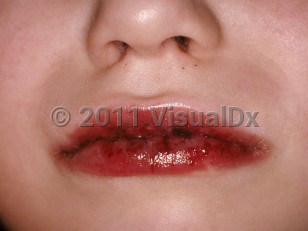- Bilateral bulbar conjunctival injection without exudate
- Oral mucosa changes: cracked lips, "strawberry tongue," or diffuse erythema of the mucosae
- Changes in the extremities: erythema, induration, or periungual peeling
- Exanthem
- Cervical lymphadenopathy (greater than 1.5 cm diameter)
A multisystem inflammatory syndrome potentially linked to COVID-19 has been reported in children and young adults; clinical features include Kawasaki-like and toxic shock syndrome-like presentations.
Adult Patient Considerations:
KD can uncommonly occur in adults. The diagnostic criteria used for pediatric patients have not yet been validated in adults, but using these criteria, both complete and incomplete forms occur in adults. It is associated with HIV infection in up to one-fifth of cases. Lymphadenopathy and joint involvement occur with a higher frequency in adults with KD than children, and cheilitis is less frequent. Cardiac complications may occur in adults including aneurysm formation; other reported cardiac complications include valvular abnormalities and heart failure. Treatment is usually delayed in adults, given delay in diagnosis, but is similar to that in children.



